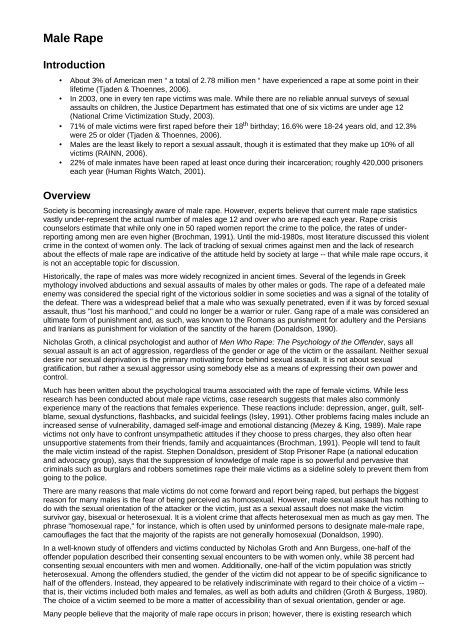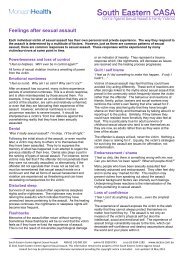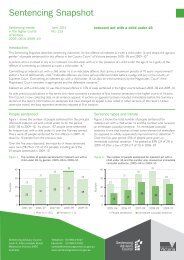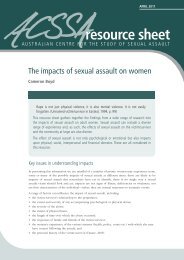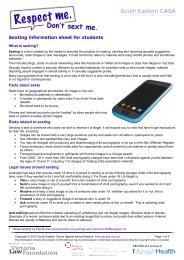Male Rape
Male Rape
Male Rape
Create successful ePaper yourself
Turn your PDF publications into a flip-book with our unique Google optimized e-Paper software.
<strong>Male</strong> <strong>Rape</strong>Introduction• About 3% of American men “ a total of 2.78 million men “ have experienced a rape at some point in theirlifetime (Tjaden & Thoennes, 2006).• In 2003, one in every ten rape victims was male. While there are no reliable annual surveys of sexualassaults on children, the Justice Department has estimated that one of six victims are under age 12(National Crime Victimization Study, 2003).• 71% of male victims were first raped before their 18 th birthday; 16.6% were 18-24 years old, and 12.3%were 25 or older (Tjaden & Thoennes, 2006).• <strong>Male</strong>s are the least likely to report a sexual assault, though it is estimated that they make up 10% of allvictims (RAINN, 2006).• 22% of male inmates have been raped at least once during their incarceration; roughly 420,000 prisonerseach year (Human Rights Watch, 2001).OverviewSociety is becoming increasingly aware of male rape. However, experts believe that current male rape statisticsvastly under-represent the actual number of males age 12 and over who are raped each year. <strong>Rape</strong> crisiscounselors estimate that while only one in 50 raped women report the crime to the police, the rates of underreportingamong men are even higher (Brochman, 1991). Until the mid-1980s, most literature discussed this violentcrime in the context of women only. The lack of tracking of sexual crimes against men and the lack of researchabout the effects of male rape are indicative of the attitude held by society at large -- that while male rape occurs, itis not an acceptable topic for discussion.Historically, the rape of males was more widely recognized in ancient times. Several of the legends in Greekmythology involved abductions and sexual assaults of males by other males or gods. The rape of a defeated maleenemy was considered the special right of the victorious soldier in some societies and was a signal of the totality ofthe defeat. There was a widespread belief that a male who was sexually penetrated, even if it was by forced sexualassault, thus "lost his manhood," and could no longer be a warrior or ruler. Gang rape of a male was considered anultimate form of punishment and, as such, was known to the Romans as punishment for adultery and the Persiansand Iranians as punishment for violation of the sanctity of the harem (Donaldson, 1990).Nicholas Groth, a clinical psychologist and author of Men Who <strong>Rape</strong>: The Psychology of the Offender, says allsexual assault is an act of aggression, regardless of the gender or age of the victim or the assailant. Neither sexualdesire nor sexual deprivation is the primary motivating force behind sexual assault. It is not about sexualgratification, but rather a sexual aggressor using somebody else as a means of expressing their own power andcontrol.Much has been written about the psychological trauma associated with the rape of female victims. While lessresearch has been conducted about male rape victims, case research suggests that males also commonlyexperience many of the reactions that females experience. These reactions include: depression, anger, guilt, selfblame,sexual dysfunctions, flashbacks, and suicidal feelings (Isley, 1991). Other problems facing males include anincreased sense of vulnerability, damaged self-image and emotional distancing (Mezey & King, 1989). <strong>Male</strong> rapevictims not only have to confront unsympathetic attitudes if they choose to press charges, they also often hearunsupportive statements from their friends, family and acquaintances (Brochman, 1991). People will tend to faultthe male victim instead of the rapist. Stephen Donaldson, president of Stop Prisoner <strong>Rape</strong> (a national educationand advocacy group), says that the suppression of knowledge of male rape is so powerful and pervasive thatcriminals such as burglars and robbers sometimes rape their male victims as a sideline solely to prevent them fromgoing to the police.There are many reasons that male victims do not come forward and report being raped, but perhaps the biggestreason for many males is the fear of being perceived as homosexual. However, male sexual assault has nothing todo with the sexual orientation of the attacker or the victim, just as a sexual assault does not make the victimsurvivor gay, bisexual or heterosexual. It is a violent crime that affects heterosexual men as much as gay men. Thephrase "homosexual rape," for instance, which is often used by uninformed persons to designate male-male rape,camouflages the fact that the majority of the rapists are not generally homosexual (Donaldson, 1990).In a well-known study of offenders and victims conducted by Nicholas Groth and Ann Burgess, one-half of theoffender population described their consenting sexual encounters to be with women only, while 38 percent hadconsenting sexual encounters with men and women. Additionally, one-half of the victim population was strictlyheterosexual. Among the offenders studied, the gender of the victim did not appear to be of specific significance tohalf of the offenders. Instead, they appeared to be relatively indiscriminate with regard to their choice of a victim --that is, their victims included both males and females, as well as both adults and children (Groth & Burgess, 1980).The choice of a victim seemed to be more a matter of accessibility than of sexual orientation, gender or age.Many people believe that the majority of male rape occurs in prison; however, there is existing research which
shatters this myth. A study of incarcerated and non-incarcerated male rape victims in Tennessee concluded thatthe similarities between these two groups would suggest that the sexual assault of men may not be due toconditions unique to a prison and that all men are potential victims (Lipscomb et al., 1992).Research indicates that the most common sites for male rape involving post-puberty victims are outdoors in remoteareas and in automobiles (the latter usually involving hitchhikers). Boys in their early and mid-teens are more likelyto be victimized than older males (studies indicate a median victim age of 17). The form of assault usually involvespenetration of the victim anally and/or orally, rather than stimulation of the victim's penis. Gang rape is morecommon in cases involving male victims than those involving female victims. Also, multiple sexual acts are morelikely to be demanded, weapons are more likely to be displayed and used, and physical injury is more likely tooccur, with the injuries that do occur being more serious than with injured female rape victims (Porter, 1986).DefinitionSexual assault and rape include any unwanted sexual acts. The assailant can be a stranger, an acquaintance, afamily member, or someone the victim knows well and trusts. <strong>Rape</strong> and sexual assault are crimes of violence andare used to exert power and control over another person. The legal definitions of rape and sexual assault can varyfrom state to state (National Center for Victims of Crime, GetHep Series: Sexual Assault Legislation). However,usually a sexual assault occurs when someone touches any part of another person's body in a sexual way, eventhrough their clothes, without that person's consent. <strong>Rape</strong> of males is any kind of sexual assault that involvesforced penetration of the anus or mouth by a penis, finger or any other object. Both rape and sexual assaultincludes situations when the victim cannot say "no" because he is disabled, unconscious, drunk or high.In some states, the word "rape" is used only to define a forced act of vaginal sexual intercourse, and an act offorced anal intercourse is termed "sodomy." In some states, the crime of sodomy also includes any oral sexual act.There are some states that now use gender-neutral terms to define acts of forced anal, vaginal or oral intercourse.Also, some states no longer use the terms "rape" and "sodomy," rather all sex crimes are described as sexualassaults or criminal sexual conduct of various degrees depending on the use and amount of force or coercion onthe part of the assailant (National Center for Victims of Crime, GetHep Series: Sexual Assault Legislation).Victims' ResponseIt is not uncommon for a male rape victim to blame himself for the rape, believing that he in some way gavepermission to the rapist (Brochman, 1991). <strong>Male</strong> rape victims suffer a similar fear that female rape victims face --that people will believe the myth that they may have enjoyed being raped. Some men may believe they were notraped or that they gave consent because they became sexually aroused, had an erection, or ejaculated during thesexual assault. These are normal, involuntary physiological reactions. It does not mean that the victim wanted to beraped or sexually assaulted, or that the survivor enjoyed the traumatic experience. Sexual arousal does notnecessarily mean there was consent.According to Groth, some assailants may try to get their victim to ejaculate because for the rapist, it symbolizestheir complete sexual control over their victim's body. Since ejaculation is not always within conscious control butrather an involuntary physiological reaction, rapists frequently succeed at getting their male victims to ejaculate. AsGroth and Burgess have found in their research, this aspect of the attack is extremely stressful and confusing to thevictim. In misidentifying ejaculation with orgasm, the victim may be bewildered by his physiological response duringthe sexual assault and, therefore, may be discouraged from reporting the assault for fear his sexuality may becomesuspect (Groth & Burgess, 1980).Another major concern facing male rape victims is society's belief that men should be able to protect themselvesand, therefore, it is somehow their fault that they were raped. The experience of a rape may affect gay andheterosexual men differently. Most rape counselors point out that gay men have difficulties in their sexual andemotional relationships with other men and think that the assault occurred because they are gay, whereas straightmen often begin to question their sexual identity and are more disturbed by the sexual aspect of the assault thanthe violence involved (Brochman, 1991).<strong>Male</strong> <strong>Rape</strong> as an Act of Anti-Gay ViolenceUnfortunately, incidents of anti-gay violence also include forcible rape, either oral or anal. Attackers frequently useverbal harassment and name-calling during such a sexual assault. Given the context of coercion, however, suchtechnically homosexual acts seem to imply no homosexuality on the part of the offenders. The victim serves, bothphysically and symbolically, as a "vehicle for the sexual status needs of the offenders in the course of recreationalviolence" (Harry, 1992, p.115).If You Are a Victim<strong>Rape</strong> and sexual assault include any unwanted sexual acts. Even if you agree to have sex with someone, you havethe right to say "no" at any time, and to say "no" to any sexual acts. If you are sexually assaulted or raped, it isnever your fault -- you are not responsible for the actions of others.
Richie J. McMullen, author of <strong>Male</strong> <strong>Rape</strong>: Breaking the Silence on the Last Taboo, encourages seeking immediatemedical attention whether or not the incident is reported to police. Even if you do not seem injured, it is important toget medical attention. Sometimes injuries that seem minor at first can get worse. Survivors can sometimes contracta sexually transmitted disease during the sexual assault, but not suffer immediate symptoms. Even if the symptomsof that disease take weeks or months to appear, it might be easily treated with an early diagnosis. (If you areconcerned about HIV exposure, it is important to talk to a counselor about the possibility of exposure and the needfor testing. For more information about HIV transmission and testing, contact the Centers for Disease ControlNational HIV/AIDS Hotline. Check the contact list at the end of this bulletin for the phone number and addressinformation.)Medical considerations making immediate medical attention imperative include:Rectal and anal tearing and abrasions which may require attention and put you at risk for bacterialinfections;Potential HIV exposure; andExposure to other sexually transmitted diseases.If you plan to report the rape to the police, an immediate medical examination is necessary to collect potentialevidence for the investigation and prosecution.Some of the physical reactions a survivor may experience in response to the trauma of a sexual assault or rapeinclude:Loss of appetite;Nausea and/or stomachaches;Headaches;Loss of memory and/or concentration; and/orChanges in sleep patterns.Some of the psychological and emotional reactions a sexual assault survivor may experience include:Denial and/or guilt;Shame or humiliation;Fear and a feeling of loss of control;Loss of self-respect;Flashbacks to the attack;Anger and anxiety;Retaliation fantasies (sometimes shocking the survivor with their graphic violence);Nervous or compulsive behavior;Depression and mood swings;Withdrawal from relationships; andChanges in sexual activity.Survivors of rape, and often of attempted rape, usually manifest some elements of what has come to be called<strong>Rape</strong>-Related Posttraumatic Stress Disorder (RR-PTSD), a form of Posttraumatic Stress Disorder (PTSD) . Apartfrom a small number of therapists and counselors specializing in sexual assault cases, few psychotherapists arefamiliar with the symptoms and treatment of RR-PTSD. For this reason, a rape survivor is usually well-advised toconsult with a rape crisis center or someone knowledgeable in this area rather than relying on general counselingresources. The same applies to those close to a rape victim, such as a partner, spouse or parent; these personsbecome secondary victims of the sexual assault and have special issues and concerns that they may needassistance in dealing with effectively.Local rape crisis centers offer male sexual assault victims direct services or referrals for services, including:counseling, crisis services and support services. Victims may contact their local rape crisis center, no matter howlong it has been since the rape occurred. Counselors on staff can either provide support, or help direct the victim totrained professionals who can provide support. Most rape programs are staffed by women; however, someprograms have male and female counselors. If you prefer one or the other, make that preference known when youinitially contact the program. Whether or not they have male staff on call, almost all rape crisis centers can makereferrals to male counselors sensitive to the needs of male sexual assault survivors. In addition, many communitiesacross the country have support groups for victims of anti-gay violence.Counseling can help you cope with the physical and emotional reactions to the sexual assault or rape, as well asprovide you with necessary information about medical and criminal justice system procedures. Seeking counselingis an important way to regain a sense of control over your life after surviving a sexual assault. Contact your localrape crisis program even if services are not expressly advertised for male rape survivors. The number can be foundin your local phone book listed under "Community Services Numbers," "Emergency Assistance Numbers," "SurvivalNumbers" or "<strong>Rape</strong>."Sexual assault and rape are serious crimes. As a sexual assault survivor, you have the right to report the crime tothe police. This decision is one only you can make. But because authorities are not always sensitive to malesexual assault victims, it is important to have a friend or advocate go with you to report the crime for support andassistance.
ReferencesBrochman, Sue. (July 30, 1991). "Silent Victims: Bringing <strong>Male</strong> <strong>Rape</strong> Out of the Closet." The Advocate, 582: 38 -43.Bureau of Justice Statistics. (1997). Criminal Victimization in the United States, 1994. Washington, DC: Bureau ofJustice Statistics, U.S. Department of Justice.Bureau of Justice Statistics. (March 1985). The Crime of <strong>Rape</strong>. Washington, DC: Bureau of Justice Statistics, U.S.Department of Justice.Donaldson, Donald. (1990). "<strong>Rape</strong> of <strong>Male</strong>s," in Dynes, Wayne, ed. Encyclopedia of Homosexuality.New York:Garland Publications.Groth, A. Nicholas and Ann Wolbert Burgess. (1980). "<strong>Male</strong> <strong>Rape</strong>: Offenders and Victims." American Journal ofPsychiatry,137(7): 806 - 810.Groth, A. Nicholas and B. A. Birnbaum. (1979). Men Who <strong>Rape</strong>: The Psychology of the Offender.New York:Plenum.Harry, Joseph. (1992). "Conceptualizing Anti-Gay Violence," in Herek, Gregory and Kevin Berrill, eds. Hate Crimes:Confronting Violence Against Lesbians and Gay Men.Newbury Park, CA: Sage Publications.Human Rights Watch, 2001.Isley, Paul. (1991). "Adult <strong>Male</strong> Sexual Assault in the Community: A Literature Review and Group TreatmentModel," in Burgess, Ann, ed. <strong>Rape</strong> and Sexual Assault III: A Research Handbook.New York: Garland Publishing,Inc.Lipscomb, Gary H. et al. (1992). "<strong>Male</strong> Victims of Sexual Assault." Journal of the American MedicalAssociation,267(22): 3064 - 3066.McMullen, Richie J. (1990). <strong>Male</strong> <strong>Rape</strong>: Breaking the Silence on the Last Taboo. London: GMP Publishers Ltd.Mezey, Gillian and Michael King. (1989). "The Effects of Sexual Assault on Men: A Survey of 22 Victims."Psychological Medicine, 19(1): 205 - 209.National Center for Victims of Crime. (1992). "<strong>Rape</strong>-Related Posttraumatic Stress Disorder," Get Help Series,Washington, DCNational Center for Victims of Crime. (1995). "Sexual Assault Legislation," Get Help Series, Washington, DCNational Crime Victimization Study, 2003.Porter, Eugene. (1986). Treating the Young <strong>Male</strong> Victim of Sexual Assault. Syracuse, NY: Safer Society Press.RAINN <strong>Rape</strong>, Abuse and Incest National Network, 2006.Tjaden, P., & Thoennes, N. (2006). Extent, Nature, and Consequences of <strong>Rape</strong> Victimization: Findings From theNational Violence Against Women Survey, NIJ, CDC.BibliographyAllers, Christopher et al. (1991). "HIV Vulnerability and the Adult Survivor of Childhood Sexual Abuse." Child Abuseand Neglect, 17: 291 - 298.Baker, Timothy and Ann Burgess, Ellen Brickman and Robert Davis. (1990). "<strong>Rape</strong> Victims' Concerns AboutPossible Exposure to HIV Infection." Journal of Interpersonal Violence,5(1): 49 - 60.Bradway, Becky. (1993). Sexual Violence Facts and Statistics. Springfield, IL: Illinois Coalition Against SexualAssault.Burgess, Ann and Timothy Baker. (1992). "AIDS and Victims of Sexual Assault." Hospital and CommunityPsychiatry, 43(5): 447 - 448.Comstock, Gary. (1991). Violence Against Lesbians and Gay Men. New York: Columbia University Press.Fuller, A. Kenneth and Robert Bartucci. (1991). "HIV Transmission and Childhood Sexual Abuse." Journal of SexEducation & Therapy, 17(1).Gostin, Lawrence et al. (1994). "HIV Testing, Counseling, and Prophylaxis After Sexual Assault." Journal of theAmerican Medical Association, 271(18): 1436 - 1444.Jenny, Carole et al. (1990). "Sexually Transmitted Diseases in Victims of <strong>Rape</strong>."The New England Journal of Medicine, 322(11).National Center for Victims of Crime. (1992). Looking Back, Moving Forward: A Program for CommunitiesResponding to Sexual Assault. Arlington, VA: National Center for Victims of Crime.
National Center for Victims of Crime and Crime Victims Research and Treatment Center. (1992). <strong>Rape</strong> in America:A Report to the Nation. Arlington, VA: National Center for Victims of Crime.Copyright © 2008 by the National Center for Victims of Crime. This information may be freely distributed, providedthat it is distributed free of charge, in its entirety and includes this copyright notice.


